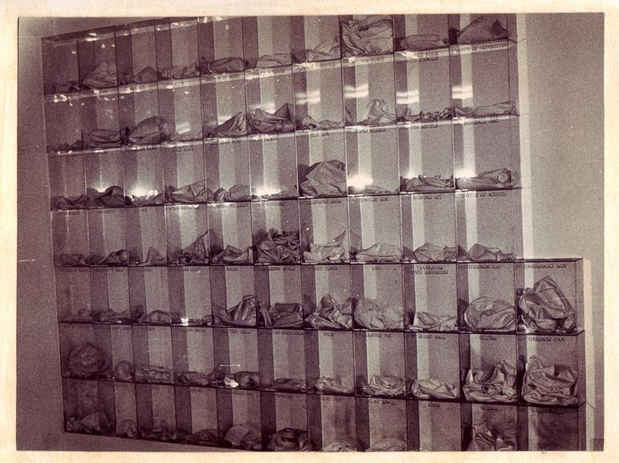Yasuo Ihara “Explanation”
ULTERIOR

[Image: Photo of Explanation 1, taken by Yasuo Ihara (circa 1973)]
This event has ended.
Ulterior Gallery presents Explanation, a solo exhibition by the late Japanese artist Yasuo Ihara. From the time Ihara moved to the United States in 1963 until he passed away in 2010, his work was rarely shown. This is the first exhibition of his work in more than a decade.
Yasuo Ihara was born in Osaka in 1932. He began showing his abstract paintings in the mid 1950s at Kodo Bijutsu Kyokai (Kodo Art Association), a nationally known art organization. His paintings attracted much attention while he was still a student at Kwansei Gakuin University. Ihara graduated in 1955 and later established Chusho Sakka Shudan Tempo (Abstract Artists Group Tempo) with other young artists based in the Kansai area in 1962. Hirokazu Moriguchi, Masaya Sakamoto, and Ihara, who were already showing their work at Kodo Bijutsu Kyokai, converged and founded Tempo with Sadamu Kanki, Yasunobu Nakanishi, and Aine Kinashi, a member of the recently dissolved avant-garde Group Delta. Tempo received recognition as an artist group that first introduced elements of the Neo Dadaism and Pop Art of the United States into their work and exhibited it publicly in Japan.
Widely expected in Kansai to become one of the leading figures of the new generation of artists, Ihara was determined to move to New York, the center of avant-garde art in this era, and finally did so in December 1963. (Tempo dissolved around the same time, with Ihara’s colleagues Kinashi and Sakamoto joining Gutai Art Collective.) Although Ihara returned to Japan for two years between 1968 and 1970, Ihara lived in New York and continued making art until he passed away in 2010.
Ihara was originally a painter and was highly regarded as such in the Kansai art community. However, he began questioning the meaning of abstract painting soon after arriving in New York. He started experimenting with more direct forms of expression such as performance in the mid to late ‘60s, and presented the performance art pieces The Five Men at Judson Church in New York in 1964 and A Very Merry Un-Birthday at Osaka Art Center in Osaka in 1970. After such time-based forms of art, he began to engage with more conceptually structured works, including the series called Explanation. Explanation 1, on view in the gallery, has never before been exhibited publicly.
Ihara began conceiving Explanation 1 in 1971 and it took several years to complete. He used rubber latex to make a cast or “skin” of daily objects that he found around him and his family at home. These skins were placed in a Plexiglas box and sealed individually. While labels affixed to the boxes identify their contents—“TELEPHONE,” “BOTTLE OF COCA COLA,” “GARBAGE CAN,” “CANDLESTICK WITH CANDLE”—the crumpled latex molds bear little resemblance to what they originally encased. The forms are emptied out, largely immaterial, like the husks of insects or the discarded skins of snakes. Originally seventy-three boxes were included in this work, but Ihara later separated five elements and re-packaged them with one added unit. This group of six elements (“LOG,” “ITALIAN BREAD,” “CANTALOUPE,” “PUMPKIN,” “STONE,” “FACE OF HERMES”) is also on view in the gallery.
As an immigrant, Ihara lived and worked between two languages and cultures, and was little known as an artist in New York. His pursuit to create new artworks in his studio, alone in a foreign culture, forced him to critically examine the surface of things and the core reality beneath. Ihara’s interest was to expose the given conditions of his surroundings and question the essentials of the world he belonged to.
Also on view is Ihara’s Transformation Pills, 1993, a sculptural work in the form of a medicine shelf with sixteen bottles of various pills. Each bottle is labeled with a derogatory term for different races. The work suggests what Ihara’s reality might have been like and how he transmuted or “bottled” the everyday bigotry he witnessed or encountered.
After his move to New York, Ihara’s work was rarely shown publicly, even in Japan. In recent years, however, his work, and his position as a cross-cultural or “migrant” artist, has received renewed attention. In 2017 the National Museum of Modern Art, Kyoto acquired two of his works from the New York era. His work is also in the collection of the Takamatsu Museum of Art, Hyogo Prefectural Museum of Art, Tokushima Modern Art Museum, and Osaka Prefecture. During his lifetime, Yasuo Ihara’s work was exhibited at Frederick Teuscher Gallery, New York, NY (1965); Judson Church, New York, NY (1966); Stony Brook University, New York, NY (1967); Hyogo Prefectural Museum of Modern Art, Kobe, Japan (1994), and several other venues in Japan. His newly acquired works at the National Museum of Modern Art, Kyoto are scheduled to be on view in 2018.
Media
Schedule
from December 16, 2017 to January 21, 2018
Opening Reception on 2017-12-16 from 18:00 to 20:00